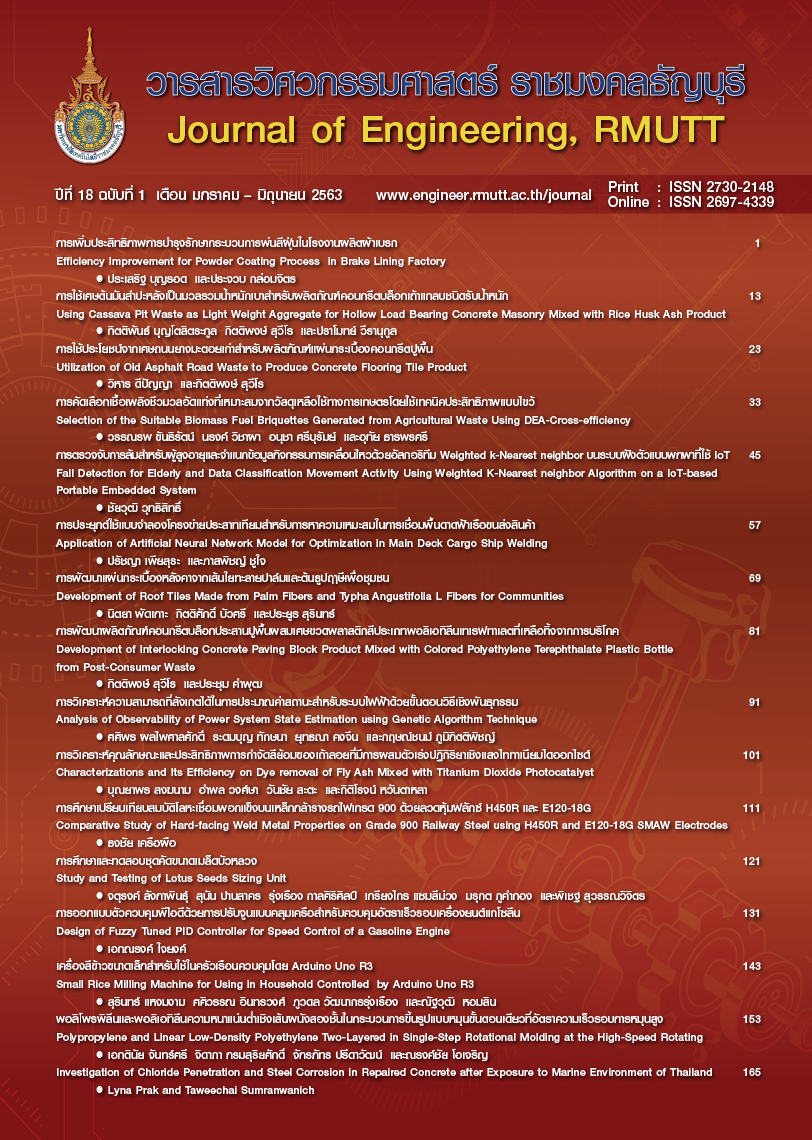Polypropylene and Linear Low-Density Polyethylene Two-Layered in Single-Step Rotational Molding at the High-Speed Rotating
Main Article Content
Abstract
The objective of this research has studied the molding of two-layered products in one-step rotational molding process at high-speed rotation. In this research, polypropylene (PP) with different sizes and shapes of particles were used to mixed with linear low-density polyethylene (LLDPE) with powder particles, using the single-axis rotation machine for molding, mixing by dry blend method at 50:50 ratios, the rotational speed at 60 rpm, during molding the temperature change within the mold and the particles movement behavior was observed and recorded. The results show clearly that high-speed rotation can cause the sample to be separated as two-layered in all cases, the surface roughness both inside and outside has reduced, and the sample had higher an initial modulus when compared to low-speed rotation except in the case of PP with round shape and 3 times larger than LLDPE
Article Details
The manuscript, information, content, picture and so forth which were published on Frontiers in engineering innovation research has been a copyright of this journal only. There is not allow anyone or any organize to duplicate all content or some document for unethical publication.
References
Iwakura K, Ohta Y, Chen CH, White J.Experimental investigation of rotational molding and the characterization of rotationally molded polyethylene-parts.International PolymerProcessing. 1989;4(3):163-71.
Qin L, Ding Y-M, Zhu G-C, Yu H-C, Yang W-M. Heat flow analysis and efficiency optimization of rotational molding equipment for large plastic products. International Polymer Processing.2015;30(2):194-201.
Crawford RJ, Crawford RJ, Throne JL. Rotationalmolding technology: WilliamAndrew; 2001.
Kulikov O, Hornung K, Wagner M. Novel processing additives for rotational molding of polyethylene. InternationalPolymer Processing. 2009;24(5):452-62.
Ramkumar P, Kulkarni D, Chaudhari V.Parametric and mechanical characterization of linear low density polyethylene(LLDPE) using rotational mouldingtechnology. Sadhana. 2014;39(3):625-35.
Liu SJ, Yang CH. Rotational molding of two-layered polyethylene foams.Advances in Polymer Technology: Journal of the Polymer ProcessingInstitute. 2001;20(2):108-15.
Barhoumi N, Lamnawar K,Maazouz A, Jaziri M, Abdelhedi R. Reactive rotationalmolding process of PP/PA6 bilayer systems: experimental investigations. International Journal of Material Forming. 2008;1(1):671-4.
Löhner M, Drummer D. Characterization of layer built-up and inter-layer boundaries in rotational molding of multi-material parts in dependency of the filling strategy. Journal of Polymer Engineering. 2017;37(4):411-20.
Pop-Iliev R, Rizvi GM, Park CB. The importance of timely polymer sinteringwhile processing polypropylenefoams in rotational molding. PolymerEngineering & Science. 2003;43(1):40-54.
Greco A, Maffezzoli A. Powder-shape analysis and sintering behavior of high-density polyethylene powders for rotational molding. Journal ofapplied polymer science. 2004;92(1):449-60.
Olinek J, Anand C, Bellehumeur C.Experimental study on the flow and deposition of powder particles inrotational molding. Polymer Engineering& Science. 2005;45(1):62-73.
JansriE, Narongchai O. Polypropylene /polyethylene two-layered by one-step rotational molding. Journal of Polymer Engineering. 2018;38(7):685-94.
Spence A, Crawford R. The effect of processing variables on the formation and removal of bubbles in rotationallymolded products. Polymer Engineering& Science. 1996;36(7):993-1009.
Chaudhary BI, Takacs E, Vlachopoulos J. Processing enhancers for rotational molding of polyethylene.Polymer Engineering & Science. 2001;41(10):1731-42.
DaCosta HM, Ramos VD, De Oliveira MG. Degradation of polypropylene (PP) during multiple extrusions: Thermal analysis, mechanical properties and analysis of variance. Polymer Testing. 2007;26(5):676-84.
Da Costa, H. M, Ramos, V. D, De Oliveira, M. G. (2007). Degradation of polypropylene(PP) during multiple extrusionsThermal analysis, mechanical properties andanalysis of variance. Polymer Testing, 26(5), 676-84.
Jin H, Gonzalez-Gutierrez J, Oblak P, ZupanEiE B, Emri I. The effect ofextensive mechanical recycling on the properties of low densitypolyethylene. Polymer degradation and stability. 2012;97(11):2262-72.
Chaudhary BI, Takacs E, Vlachopoulos J. Processing enhancers for rotational molding of polyethylene. Polymer Engineering & Science. 2001;41(10):1731-42.
Sharma T, Mahanwar P, Bambole V. Study of modified polypropylene for rotationalmoulding applications.InternationalJournal of Plastics Technology. 2009;13(1):83.
Rosato DV, Schott NR, Rosato MG. Plastics Institute of America Plastics Engineering,Manufacturing & Data Handbook: Springer Science &Business Media; 2001.


